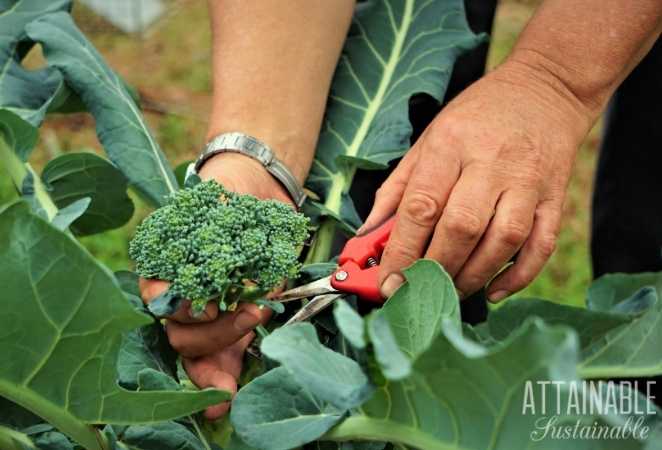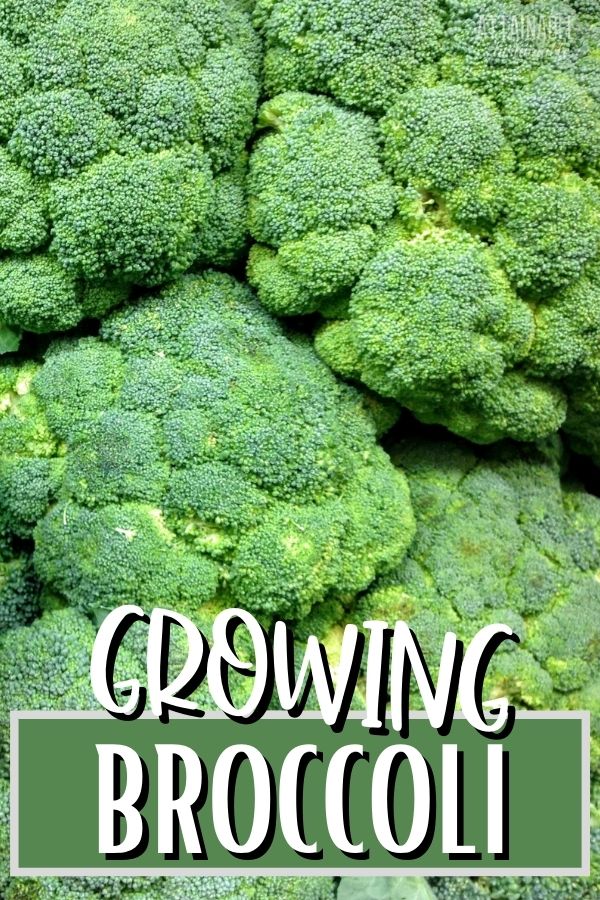Broccoli is a cruciferous vegetable and a member of the superhero mustard family. This guide to growing broccoli will get you started with growing it in your garden!
Contributed by Jodi Torpey. Originally published July 2012; this post has been updated.
All About Broccoli
Early Romans may have been the first to enjoy broccoli, but this vegetable’s popularity was slow to spread to other parts of the world. Now broccoli (Brassica oleracea) is a grocery-store staple, right up there with kale. Some clever produce companies have even started packaging the tender leaves that grow around a broccoli crown as a vegetable they call BroccoLeaf.
Timing is important when planting broccoli in the home garden. Broccoli is a cool weather crop. Broccoli heads need to be harvested while temperatures are still cool and before the summer days heat up. If the plants aren’t in the ground in early spring, they’ll quickly bolt once the temperature starts to rise. In fact, when soil temperatures get too much above 75 degrees, the plants won’t form heads.
To solve the problem of trying to grow broccoli in high temperatures, look for varieties that can tolerate heat or those that are known to be bolt tolerant.
Another option is to plan to plant broccoli as a fall crop. Select short-season varieties, like Goliath, that take around 50 days to mature.
Grow Some Greens!
Ready to grow fresh greens, no matter WHERE you live? Sign up for my
FREE quick-start guide and start growing some of your own food!
Like other cruciferous plants, broccoli can tolerate a light frost, and some gardeners say this type of frost improves the vegetable’s flavor.
New to gardening? Limited on space? The 5-Gallon Garden gives you the skills you need to grow food in the space you have. Get started with your garden today!
4 Popular Broccoli Varieties
Select broccoli varieties for your garden that match your region and the number of days to maturity. These dates help ensure air and soil temperatures are cool enough for growing, forming heads and harvesting.
Some experts recommend planting more than one variety of broccoli to increase your chances for success.
Here are five broccoli varieties to consider:
De Cicco is an open-pollinated, heading broccoli that originated in Italy. Gardeners like this variety because it matures in 50-60 days and produces side shoots after the main head is harvested.
Solstice is another open-pollinated variety that matures in over 70 days. Medium to large heads grow on vigorous plants with side shoots that continue to grow when planted in spring or fall.
Burgundy is a hybrid broccoli that grows bright purple florets on light green stems. A short-season grower at 37-45 days, gardeners in some regions can get three seasons of this attractive vegetable.
Artwork is a 2015 All-America Selections vegetable winner. Artwork is a stem broccoli, also called baby broccoli, because of the dark green, long stems. This broccoli starts out as a traditional crown broccoli, but after the first harvest, the shoots grow on long stems into the season; 55 days to maturity.
Imperial is a hybrid broccoli seed that has excellent heat tolerance. It’s the seed that does best for Kris in her Hawai’i garden.
How to Plant Broccoli
If starting from seed, plant broccoli seeds indoors about 6-8 weeks before the last frost date and the estimated planting date for your region. Otherwise, buy broccoli seedlings when they’re available at garden centers to help speed the planting process.
In fall, sow seeds about 12 weeks before the first fall frost, although if the winters are mild, you can sow crops through winter.
Time the planting carefully so that broccoli heads will mature while the weather is cool, either in summer or fall. Measure soil temperature and plant when the soil is in the 55-65 degree range.
Plant transplants by spacing them about 12-24 inches between plants; about 20-36 inches between rows. Mulch with straw, dried untreated grass clippings or other organic material; water in.
Requirements for Growing Broccoli
Light Requirements
Broccoli is a plant that likes at least six hours of sunshine; full sun is ideal. However, broccoli plants can take a little shade, and partial sun works great when you need to plant in the middle of a hot summer for fall harvests.
Be sure to plant in an area that will be easy to get to when the broccoli is ready to harvest, no matter which season.
Soil Requirements
Broccoli needs rich, well-draining soil to produce good-sized heads. Amend the garden bed with plenty of organic matter, like compost, well-aged manure or other high-nitrogen fertilizer. Broccoli plants will need plenty of nitrogen to grow good-quality heads of broccoli.
Water and Fertilizer Requirements
Keep the garden soil moist, but not soggy and don’t let plants dry out completely.
A few weeks after planting, give broccoli plants a feeding of compost tea. When you see broccoli heads start to form, side-dress plants with compost or a balanced fertilizer (5-10-10) to keep broccoli growing.
To side-dress, scatter dry fertilizer on both sides of the row of broccoli plants, about 6-8 inches from the plant, rake the fertilizer into the soil and then water.
Organic gardeners may choose to fertilize with fish emulsion instead.
How to Deal with Common Broccoli Pests
If broccoli pests ruin your enthusiasm for planting this good-for-you vegetable, choose to plant in fall and avoid planting in spring. Common pest problems are less of an issue then.
Cabbage loopers, cabbage worms, snails and slugs all like broccoli leaves and florets. First, use row cover cloth over plants to keep the white butterfly-like moths from laying eggs near plants. Second, handpick any green caterpillars on broccoli and the undersides of leaves and dispose of them in a bucket of soapy water.
Slugs and snails can be trapped with a shallow dish of beer or a yeast-water mixture placed on the ground near plants. Diatomaceous earth sprinkled around plant stems is another method to get rid of slugs and snails. Go here for more on controlling slugs and snails.
Aphids are tiny pests that make broccoli leaves curl after sucking sap from the leaves. Check the undersides of leaves and give them a strong blast of water from the hose. Several applications may be needed to get rid of the little suckers.
Flea beetles make little holes in leaves and can be stopped with row cover cloth. Be sure to seal the cloth to the edges around plants or cover individual plants.
Consider dill as companion plants for broccoli in the garden or near where you’re growing broccoli containers. It can attract predatory wasps that lay their eggs in the cabbage butterfly caterpillars, killing them.
Growing Broccoli in Containers
Container gardening is a great way for urban gardeners to grow some food; broccoli can be grown in containers as well as in the ground. Choose a 12 inch deep container at minimum; deeper is fine. A five-gallon bucket would be a good size.
As with planting other vegetables in containers, use a potting mix that’s meant for container planting and not garden soil. Mix in some compost so that the soil is rich and well-draining.
One broccoli plant per container will work best, unless the container has a very large opening.
Choose a smaller broccoli variety for planting in pots, such as Artwork or Solstice, that produce a lot of side shoots on plants.
Harvesting and Using Broccoli in the Kitchen
When broccoli heads are dark green (or purple), tight and about 4-6 inches in diameter, use pruners or a sharp knife to cut them from plants, but leave a long stem attached. If yellow buds have formed on the heads, it means the broccoli is past its prime.
After cutting the central head, leave plants in place and side dress with a high-nitrogen fertilizer to help the plants form strong, lateral shoots. These side shoots will grow a number of smaller, compact broccoli heads that are ready to harvest when they’re several inches in diameter.
Experts recommend washing broccoli heads thoroughly or soaking them in salt water or warm vinegar water for 15 minutes before cooking or eating raw broccoli. This step helps wash away any hard-to-see insects that might be hiding deep inside.
Broccoli can be steamed, roasted, grilled, eaten raw or covered with cheese sauce. This broccoli salad is delicious, too! For an extra delicacy, peel the broccoli stalks and prepare them, too.
Tips for Propagating Broccoli
Plan ahead if you want to save broccoli seeds. Make sure you’re planting open-pollinated varieties and plant with plenty of space between plants to prevent cross-pollination.
When broccoli heads are fully mature, allow the plant to flower. The seeds will grow inside the flower stems which takes several months.
After the seed pods have dried, remove the entire broccoli plant from the garden and allow to dry for several more weeks.
Remove the seed pods, open each one over newspaper or other material to catch the seeds. Store broccoli seeds in a sealed container in a cool dry place, and you’ll be ready to plant more broccoli during the next growing season. You can also use the seeds to grow Broccoli Sprouts.
Love the flavor of brassicas? Consider growing your own cabbage or Brussels sprouts, too!











